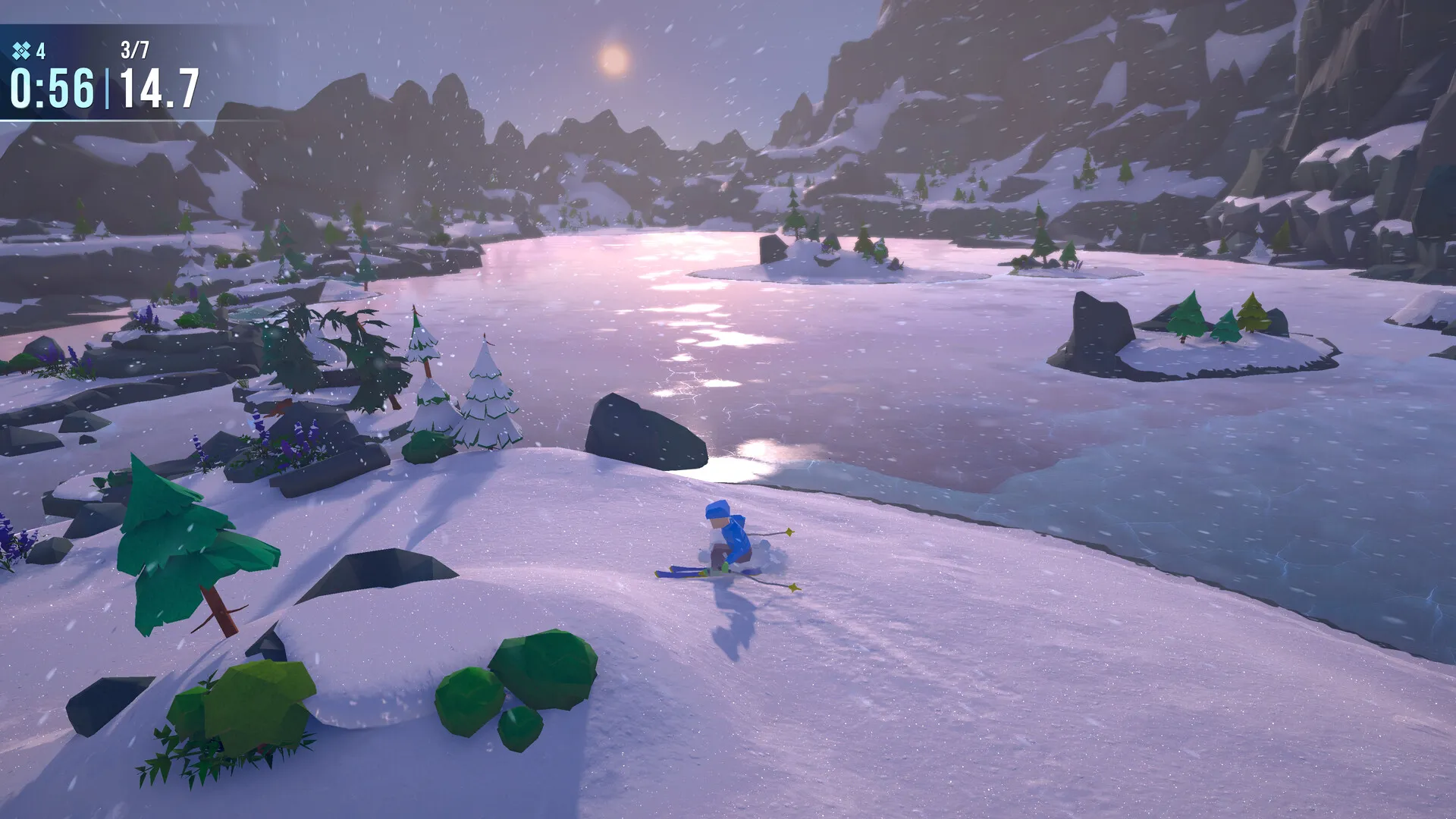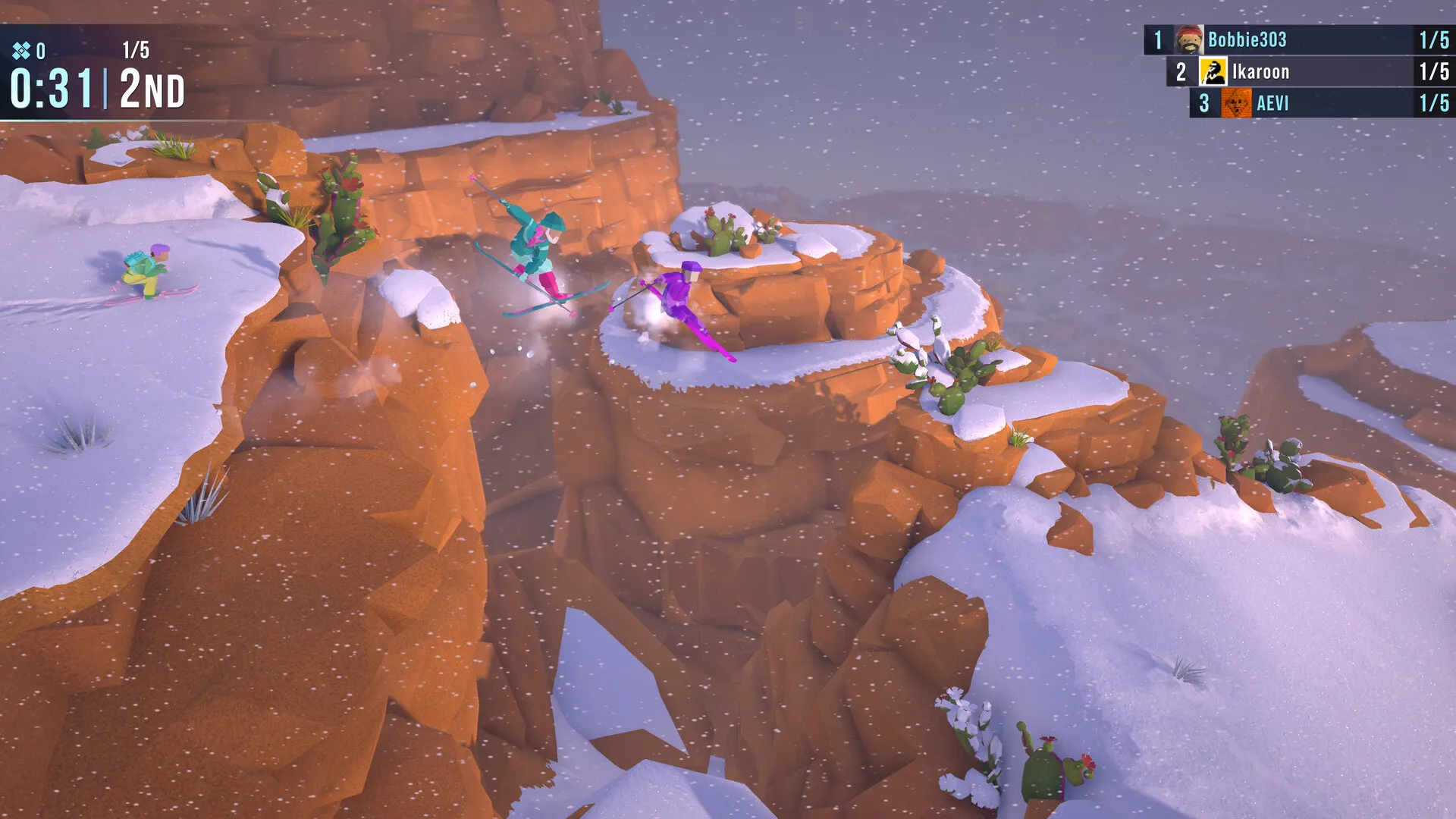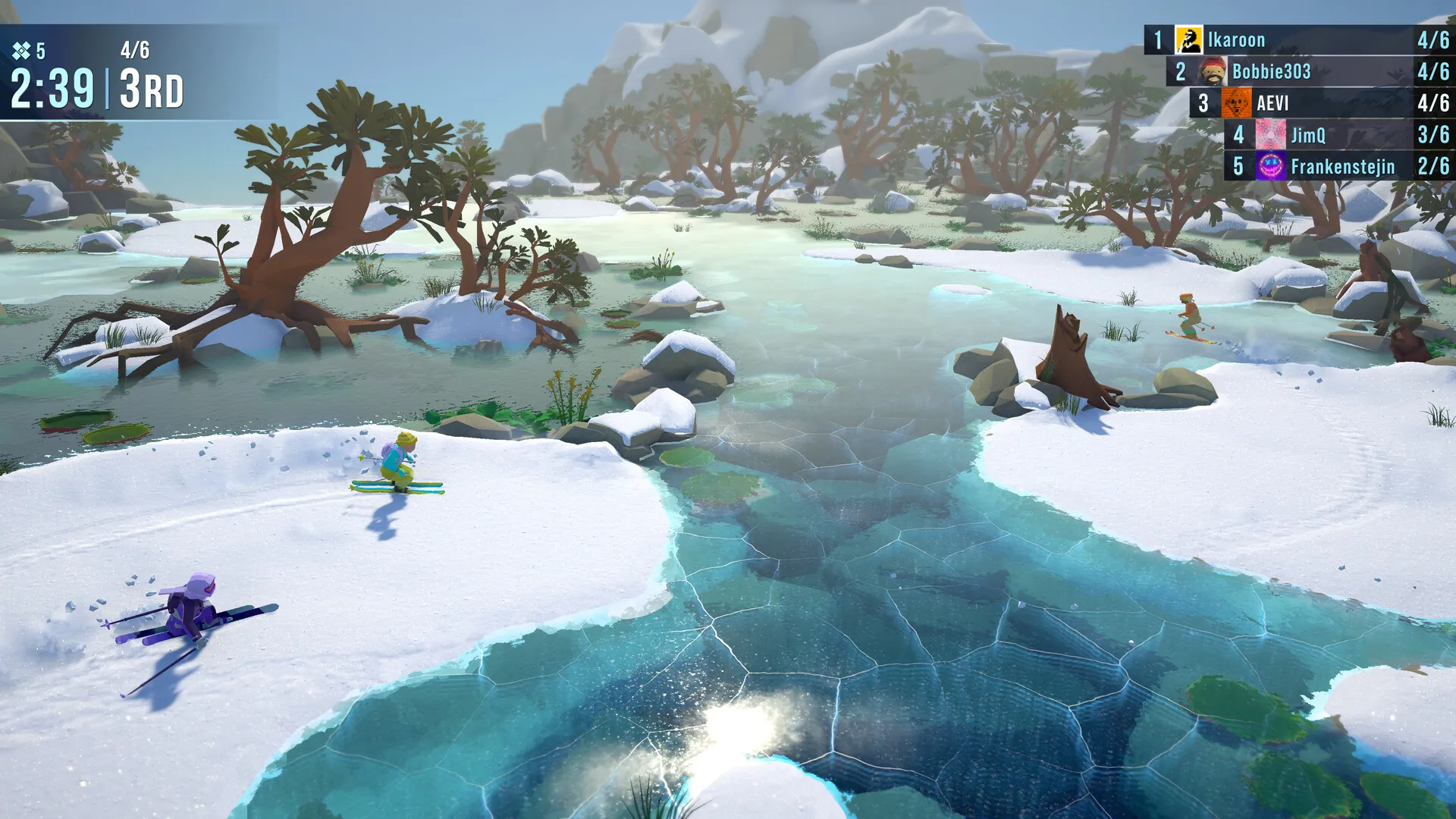Lonely Mountains: Snow Riders shifts from gravel-crunching bikes to silent ski glides across snow-covered peaks. Players face a stark challenge: navigate treacherous slopes while staying alive, balancing speed against survival. The game transforms skiing into a physical puzzle where each movement tests skill and technique. Runs create ghostly tracks in snow, turning repeated attempts into a learning experience.
The game creates tension through contrasting elements. Stark landscapes suggest quiet contemplation, yet gameplay demands intense concentration. Zen Mode allows exploratory descents without pressure, while the main mode introduces stricter challenges. Unlike other skiing games with bombastic styles, Snow Riders focuses on personal skill and incremental improvement. Players write their narrative through precise movements and gradual mastery of terrain.
Each descent becomes a meditation on control and risk. Skiers must read the mountain’s subtle contours, anticipate obstacles, and make split-second decisions. The experience strips away external narratives, leaving pure interaction between player and environment.
Ski paths emerge like delicate lines drawn across pristine white surfaces – a testament to individual technique and persistence. Success feels earned through careful practice and understanding of momentum’s delicate balance.
Physics as Poetry: How Snow Riders Turns Mechanics Into Meaning
Lonely Mountains: Snow Riders presents two control methods: screen-relative steering and left/right inputs. The screen-relative approach echoes the spatial challenges of precision platforming, requiring quick adaptations as slopes and camera angles change. Traditional directional controls offer simplicity but limit precise navigation through tight terrain.
Both control schemes center on momentum management. Crouching transforms a skier into a rapid descent mechanism, while braking requires delicate input. Tricks exist sparingly, feeling more like subtle gestures than grandiose performances.
Skiing emerges as an interaction with terrain dynamics. Skis accelerate differently compared to other descent methods, carrying speed across varied surfaces. This creates strategic choices: navigating safe paths or risking faster routes across treacherous landscapes.
Aerial dynamics intensify player challenges. Mistimed jumps result in uncontrolled trajectories, while crashes reset players without excessive punishment. The visual experience alternates between serene landscapes and sudden, unexpected interruptions.
Fixed camera perspectives offer cinematic views while occasionally creating navigation challenges. Certain terrains present visual obstacles that test player perception and adaptation skills. Players must develop spatial understanding through repeated attempts and muscle memory.
The experience suggests skill development occurs through attentive interaction with environmental challenges, rather than complete mountain domination.
Peaks and Valleys: How Level Design Shapes a Silent Saga of Mastery
Snow Riders’ three mountains—Tannenstein’s cliffside jumps, Monte Guanaco’s glacial labyrinths, and Sierra Gelida’s vertigo-inducing desert spires—create distinct environments of challenge and beauty. Tannenstein’s narrow paths demand precise movement, reminiscent of tight platforming challenges, while Monte Guanaco’s ice patches test strategic decision-making: balancing control against speed.
Sierra Gelida’s surreal shortcuts—helix-shaped ravines, geometric bridges—reward exploration with time-saving paths. Each slope variation (ice, rock, powder) transforms terrain into an interactive experience, changing how players engage with momentum.
Progression echoes skill-based game design, where learning and adaptation drive player growth. Each track’s objectives—time limits, crash quotas, hybrid challenges—function like optional skill tests, pushing players to expand their capabilities. Expert routes and gear unlocks provide incremental rewards, though cosmetic elements sometimes overshadow meaningful progression. Hidden shortcuts invite experimentation, offering moments of discovery and subtle satisfaction.
“Blue” slopes introduce players to gentle mechanics, while “Black” slopes present extreme challenges requiring near-perfect technique. Difficulty emerges from intricate level design that exposes player limitations. Tannenstein’s wide turns can become unexpected traps; Monte Guanaco’s smooth ice conceals dangerous drop-offs. The experience creates a nuanced tension between player skill and environmental challenge.
Solitude and Mayhem: The Dual Lives of a Snowbound Pilgrim
Zen Mode strips away timers and unlocks, letting players explore mountains freely. Custom checkpoints allow skiers to craft personal challenges, transforming steep slopes into playgrounds of experimentation. Sometimes checkpoints glitch, trapping skiers in terrain unexpectedly.
A misplaced marker can halt progress, requiring restarts that conflict with the mode’s relaxed approach. Zen Mode represents a subtle challenge to gaming’s reward-driven model, focusing on self-directed exploration.
Multiplayer introduces wild energy into Snow Riders’ core experience. Eight-player races create chaotic moments—tight corners become comedic collision zones reminiscent of competitive racing games. Cooperative mode includes shared checkpoints and point systems, creating team-based excitement.
Technical problems emerge through loading delays and connection drops. Player dropouts can leave multiplayer spaces feeling empty. Progression mechanics offer faster rewards compared to single-player challenges, creating tension between individual skill and group dynamics.
Snow Riders explores contrasting play styles, balancing meditative exploration with energetic group interactions.
Whispers of Winter: How Sound and Shape Forge a Mountain’s Soul
Lonely Mountains: Snow Riders creates an audio experience where silence communicates deeply. Ski edges cutting through snow, the sudden crash of a fall, wind whistling—these sounds create a raw emotional landscape. Each audio cue transforms environmental sounds into critical survival information.
The game’s visual design uses low-polygon graphics to craft distinct mountain environments. Skiers and trees appear blocky yet intentional. Different mountain regions present varied emotional terrains: pine-covered valleys with living textures, glacial landscapes radiating cold precision, rust-colored mesas suggesting desolate beauty.
Unexpected track elements like spiraling ice paths and floating stone passages introduce surreal moments that challenge player expectations. These geometric interruptions punctuate the gameplay, creating surprising visual breaks that keep players engaged.
Performance mechanics prioritize clarity. Removing visual effects sharpens the game world, turning each landscape into a precise, playable scene. The experience walks a delicate line between tactile realism and dreamlike exploration.
Threads of Identity: Customization and the Quest for Endless Descents
Snow Riders’ customization suite serves as a canvas for personal expression, steering clear of power dynamics. Unlockable outfits, skis, and helmets—spanning from neon-bright jackets to retro wooden skis—capture the cosmetic delight reminiscent of Animal Crossing, allowing players to craft a persona amid solitude.
The game sidesteps RPG-style stat inflation: Ski variations offer subtle speed or control modifications, feeling more like Stardew Valley tool refinements than Dark Souls gear transformations. This approach maintains focus on skill, potentially leaving progression-driven players wanting more.
Thematic depth emerges through carefully crafted gear like the “Frostbite” skis (etched with glacial cracks) or the “Summit Seeker” backpack—narrative elements woven through equipment design, bypassing traditional dialogue.
Player engagement relies on self-imposed challenges. Leaderboards echo Celeste’s competitive essence, where millisecond improvements become a personal quest. Experimenting with shortcuts—such as uncovering a cliffside bypass in Sierra Gelida—parallels Hollow Knight’s exploratory revelations, rewarding curiosity with novel paths.
With merely 24 levels, the game’s sustained appeal depends on multiplayer interaction, resembling Overcooked’s chaotic co-op dynamic. Without the procedural slopes of Descenders or Hades’ narrative depth, replayability hinges on players’ pursuit of perfection—a strategy that excites leaderboard enthusiasts but might alienate casual players.
Smooth 60fps performance across platforms showcases minimalist design, evoking A Short Hike’s seamless experience. Visual options like adjustable depth-of-field cater to both clarity-focused and atmosphere-seeking players. The camera—a persistent issue from Downhill—remains unpredictable. Obstructed views during tight turns mirror Hollow Knight’s occasional blind leaps, but Megagon’s reluctance to address this lingering problem feels like a missed connection with the player base.
Snow Riders presents an avatar’s quest that blends intimacy and expansiveness: a low-poly protagonist pursuing mastery in a world where style and substance coexist precariously.
The Review
Lonely Mountains: Snow Riders
Lonely Mountains: Snow Riders weaves a powerful experience combining tranquil landscapes with intense challenge. Players navigate snowy slopes through precise physics and skill-driven mechanics. The game's stripped-down visual design and audio create an immersive world where each wipeout teaches valuable lessons about control and technique. Different play modes offer contrasting experiences - Zen Mode provides calm exploration, while multiplayer delivers competitive excitement. Small technical issues occasionally interrupt the gameplay rhythm, but the core experience remains engaging. The game transforms mountain biking into an art form of movement and precision.
PROS
- Immersive, minimalist sound design amplifies tension and atmosphere.
- Tight physics-driven gameplay rewards skill and experimentation.
- Zen Mode offers stress-free exploration; multiplayer adds chaotic fun.
- Striking low-poly visuals with surreal environmental flourishes.
CONS
- Camera obstructions and legacy visibility issues.
- Multiplayer plagued by connectivity bugs and lack of bots.
- Steep difficulty spikes may frustrate casual players.




















































